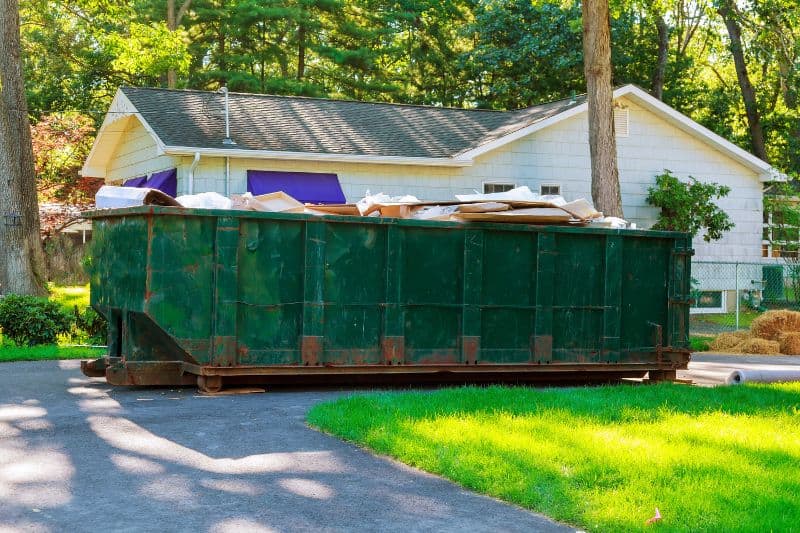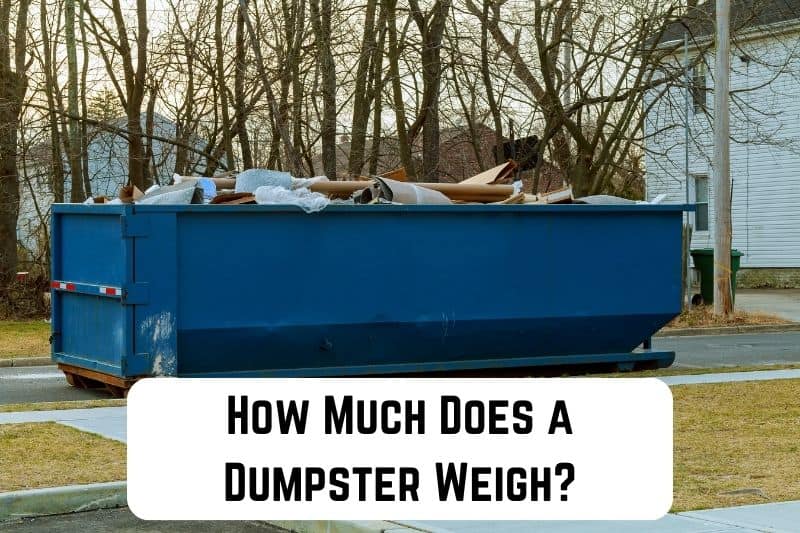When you’re planning a big project or cleanup, you may find yourself in need of a dumpster to hold all of the waste and debris. One important aspect to consider when renting a dumpster is its weight. Understanding how much a dumpster weighs can help you make informed decisions when choosing the right size container for your needs.
Dumpsters come in various sizes and designs, each with different carrying capacities and weights. To accurately determine the weight of a dumpster, you’ll need to consider both its empty weight and the weight of the materials you’ll be placing inside.
In this article, we will discuss the factors that determine the weight of a dumpster, including its size, materials used in construction, and more. This knowledge will help you select the perfect dumpster for your specific needs and budget, ensuring that your project goes smoothly and efficiently.
Read: How Much Does an Eggplant Weigh? Guide for Veggie Lovers
A small dumpsters, typically 10 cubic yards, weigh around 1 to 2 tons when empty. A 20 cubic yard dumpster can hold about 6000 pounds of waste and weigh between 2 and 3 tons when empty. Larger dumpsters, 30 cubic yard containers typically weigh between 3 and 5 tons. Largest dumpsters available are usually 40 cubic yards weigh between 4 and 6 tons.
Measuringly.com
Understanding Dumpster Sizing
When considering a dumpster for your project, it’s crucial to understand the various sizes available and how much they typically weigh. This will help you choose the right dumpster for your needs and avoid incurring additional fees for exceeding weight limits.
Dumpster sizes are commonly measured in cubic yards, indicating the debris volume they can hold. The most common residential dumpster sizes are 10, 20, 30, and 40 cubic yard containers.
10 cubic yard dumpster: This is perfect for small cleanout projects, like cleaning out your garage or a room. Depending on the materials, it can typically hold up to 4,000 pounds of debris.
20 cubic yard dumpster: This size is ideal for medium-sized projects such as remodeling a kitchen or bathroom. It can generally hold up to 6,000 pounds of debris.
30 cubic yard dumpster: Suitable for larger projects, such as whole-home renovations or major landscaping jobs, this dumpster can hold up to 10,000 pounds of debris.
40 cubic yard dumpster: This is the largest size available for most residential projects, and it’s ideal for major construction, demolition, or large-scale cleanouts. It can usually hold up to 12,000 pounds of debris.
It is essential to avoid overloading your dumpster, as this can lead to extra fees and unsafe conditions. When loading your dumpster with debris, try to distribute the weight evenly to prevent any imbalances.
It’s also crucial to note that certain materials, such as concrete and dirt, are considerably heavier than others and should be considered when choosing a dumpster size.
How Much Does a Dumpster Weigh?
When planning a project requiring a dumpster, knowing its weight capacity is important. Generally, dumpsters come in different sizes, and their weight depends on factors such as the materials used in construction and the volume of waste they can hold.
Let’s start with the smallest dumpsters, typically 10 cubic yards. These can accommodate up to 4000 pounds of debris, making them perfect for smaller projects like cleaning out a garage or basement. Expect these dumpsters to weigh around 1 to 2 tons when empty.
For medium-sized projects, a 20 cubic yard dumpster might be suitable. These dumpsters can comfortably hold about 6000 pounds of waste and usually weigh between 2 and 3 tons when empty. They are ideal for larger cleanout tasks or small construction projects.
Moving on to larger dumpsters, 30 cubic yard containers have a weight capacity of around 8000 to 10000 pounds. They typically weigh between 3 and 5 tons with no contents inside. These dumpsters are great for major construction work or large-scale cleanouts.
The largest dumpsters available are usually 40 cubic yards, able to hold up to 12000 pounds of waste. When empty, they weigh between 4 and 6 tons. These massive containers are ideal for significant renovations, new construction projects, or large commercial cleanouts.
Here is a summarized table of the dumpster sizes and their approximate weights:
| Dumpster Size (cubic yards) | Weight Capacity (lbs) | Empty Weight (tons) |
|---|---|---|
| 10 | 4,000 | 1 – 2 |
| 20 | 6,000 | 2 – 3 |
| 30 | 8,000 – 10,000 | 3 – 5 |
| 40 | 12,000 | 4 – 6 |
Remember, these figures are approximate and can vary between providers and dumpster materials. It’s essential to consult with your chosen dumpster rental company before deciding.

Typical Weights of Different Sizes of Dumpsters
When you need to rent a dumpster for a project or event, it’s important to know the typical weights of different dumpster sizes so you can make an informed decision.
Knowing the dumpster’s weight and the approximate weight of the waste you’ll be disposing of can help you avoid overage fees or select the most appropriate size for your needs.
10-Yard Dumpsters: These small dumpsters typically weigh between 2,000 and 3,000 pounds empty. They are suitable for small projects such as garage or attic cleanouts, small construction projects, or landscaping jobs. A 10-yard dumpster can hold around 4,000 to 6,000 pounds of material, depending on the density of the debris.
20-Yard Dumpsters: A medium-sized dumpster, a 20-yarder generally weighs between 3,500 and 5,000 pounds empty. This dumpster size is suitable for larger construction projects, whole-house cleanouts, or renovations. They can hold around 8,000 to 10,000 pounds of debris, depending on the type of material being discarded.
30-Yard Dumpsters: These large dumpsters usually weigh between 5,000 and 7,000 pounds empty. If you have a major construction project or are doing a significant home renovation, a 30-yard dumpster may be your best choice. They can hold approximately 12,000 to 15,000 pounds of waste material.
40-Yard Dumpsters: The largest of the standard dumpster sizes, 40-yard dumpsters typically weigh between 7,000 and 10,000 pounds empty. These dumpsters are ideal for major construction, demolition, or large scale cleanout projects. They can accommodate around 16,000 to 20,000 pounds of material.
It’s important to note that these weights are approximate and can vary depending on the construction materials used to build the dumpster. Additionally, the weight of the waste you’ll be disposing of can significantly impact the total Dumpster weight.
Factors Determining the Weight of a Dumpster
When you’re looking to rent a dumpster, it’s important to understand the factors that determine its weight. These factors will help you choose the right dumpster size and avoid any potential overage fees. Here are some key factors to consider.
Material types: Different materials have different weight. For example, household items like furniture and appliances generally weigh less than construction materials such as concrete, brick, or roofing materials. Consider the type of waste you’re disposing of before selecting a dumpster.
Volume of waste: Naturally, the more waste you’re planning to dispose of, the heavier the dumpster will be. Keep this in mind as you estimate the amount of waste you’ll be generating during your project, and select a dumpster that can accommodate those needs.
Dumpster size: Dumpsters come in various sizes, typically measured in cubic yards. Common sizes include 10, 20, 30, and 40 cubic yards. Larger dumpsters can hold more waste and subsequently, are heavier. Keep in mind that there are also weight limits for dumpsters, so don’t overload them.
Moisture: Wet waste is generally heavier than dry waste. For example, when exposed to rain or moisture, wood and other organic materials can become significantly heavier. This is especially important when disposing of yard waste, such as leaves and branches. Make sure to account for this possibility when selecting your dumpster.
How Much Does a 20-Yard Dumpster Weigh?
A 20-yard dumpster is a popular choice for residential and commercial projects. Knowing its weight is essential, especially when dealing with weight restrictions and disposal fees. So, let’s dive into how much a 20-yard dumpster weighs.
An empty 20-yard dumpster weighs between 2,000 to 3,000 pounds (1 to 1.5 tons). However, this weight might slightly vary based on materials and design. Remember that the dumpster’s weight is only one part of the equation.
Depending on the rental company’s rules, the maximum weight allowed for a 20-yard dumpster varies between 3,000 to 6,000 pounds (1.5 to 3 tons) of debris. To help you visualize, here are some items and their approximate weights:
- 1 cubic yard of asphalt shingles: 425 pounds
- 1 cubic yard of drywall: 500 pounds
- 1 cubic yard of concrete: 4,050 pounds
Now, let’s imagine you’re working on a roofing project. If your dumpster allows you to dispose of 3 tons of debris, you can calculate:
3 tons (6,000 pounds) / 425 pounds per cubic yard of shingles ≈ 14 cubic yards of shingles
This calculation tells you that a 20-yard dumpster would be sufficient for your roofing project, leaving some extra space for additional debris.
When renting a dumpster, always inform the rental company about the type of debris you’ll be disposing of, so they can guide you on the most appropriate size and weight allowance. Furthermore, remember that overloading the dumpster could result in extra fees, safety hazards, and possible damage to your driveway or property.

Materials and Their Impact on Dumpster Weight
Concrete
When disposing of concrete waste, you should remember that it is a heavy material. It is usually measured in pounds per square foot, and a cubic yard of concrete can weigh up to 4,050 pounds.
When you fill up a dumpster with concrete, make sure not to exceed its weight limit. Renting a specific heavy-duty dumpster is usually recommended for this type of waste.
Wood
Wood waste, like lumber, pallets, or branches, is relatively lighter than concrete. However, it can still contribute to the overall weight of your dumpster. Depending on the type of wood, its density can vary.
For instance, hardwoods like oak or maple are heavier than softwoods like pine or cedar. It’s essential to keep these differences in mind as you fill the dumpster with wood waste.
Metal
Metal waste, such as steel, aluminum, or copper, can significantly increase the dumpster’s weight. Generally, metal is denser and heavier than wood but lighter than concrete. Its weight will depend on the type and thickness of the metal.
For example, a cubic steel yard could weigh up to 5,000 pounds. Be aware of the metal products you are disposing of and stay within the weight limit of your dumpster.
Garden Waste
Garden waste, including grass clippings, leaves, and small branches, typically weighs less than other materials on this list. However, this waste can become heavier when it’s wet or compressed.
Keep garden waste dry and avoid overloading your dumpster with too many compacted layers. Doing so will help prevent exceeding the weight limit and ensure efficient waste disposal.
Read: How Much Do Punching Bags Weigh? Guide for Fitness Enthusiasts
How to Estimate Dumpster Weight?
When you need to rent a dumpster, estimating its weight is essential to avoid overloading and to determine the appropriate size. In this section, you’ll learn how to calculate the weight of a dumpster, so that you can choose the right one for your project.
First, familiarize yourself with the different sizes of dumpsters available, as they often come in 10, 20, 30, and 40-yard capacities. Each size is designed to hold a specific weight, typically between 2,000 and 10,000 pounds. Keep in mind that the dumpster’s size does not only affect its weight capacity but also its physical dimensions.
To estimate the weight of the materials you will be putting in the dumpster, research the average weight per cubic yard of each type of material. For instance, a cubic yard of concrete weighs around 4,050 pounds, while a cubic yard of mixed debris weighs about 1,000 pounds. You can create a simple list to reference as you fill the dumpster:
- Concrete: 4,050 lbs/cubic yard
- Asphalt: 3,500 lbs/cubic yard
- Dirt: 2,000 lbs/cubic yard
- Mixed debris: 1,000 lbs/cubic yard
Once you have determined the weight of each material, multiply it by the volume in cubic yards you plan to dispose of. For example, if your project involves disposing of 6 cubic yards of concrete, the estimated weight would be 6 x 4,050 = 24,300 pounds.
Finally, add up the calculated weights for all materials and compare the total weight with the dumpster’s weight capacity. Make sure not to exceed the limit, as you may face additional fees or even the denial of service from the rental company.







